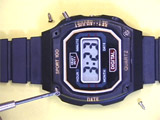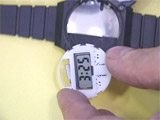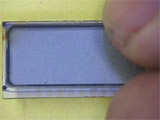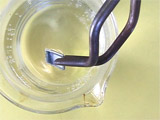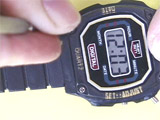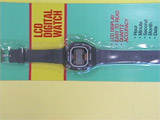
Disassembly of a Liquid Crystal Watch
Procedure developed by S. M. Condren and G. C. Lisensky.
This experiment deals with the disassembly of an inexpensive liquid crystal display (LCD) watch and testing several of the properties of the LCD panel.
| Procedure | Wear eye protection |
Remove the front or back plate to access the interior. Your watch may be slightly different from the one shown here. If screws are removed, place them in a small container for safe keeping since tiny parts can be easily lost. Remove the watch assembly from the band. Slowly rotate a polarizer above the LCD panel. Does the orientation make a difference? Remove the four tiny screws holding the printed circuit board and battery retainer to the white plastic inner case. Remove the electrically conducting pad and the LCD panel. Place the screws, switch contacts, and battery contacts into a small container for safe keeping. Examine the LCD panel and find the contact area of the panel on the bottom of the wider glass plate. Use a battery snap connected to 9-V battery. Hold one of the leads against the contact area at one end of the panel and rub the other lead along the contact area to address various segments of the LCD panel. Under pressure liquid crystal materials, such as used in LCD watches, undergo dramatic color changes. When a liquid crystal melts, the molecules become less ordered and the display appears black. The change is reversible if the heating is not too severe. The temperature for the liquid crystals to liquid phase transition can be measured using a hot water bath and a thermometer. This step is not totally reversible. Remove the top polarizer by carefully prying up one corner and then gently peeling it away. This step is not totally reversible. Cut the polarizer in half with scissors. Place one half back on the panel in its original orientation. Place the other half back after rotating 90 degrees. Use a battery snap connected to 9-V battery. Hold one of the leads against the contact area at one end of the panel and rub the other lead along the contact area to address various segments of the LCD panel. Does the orientation make a difference? With care, the watch can be reassembled in working order.
- An inexpensive LCD watch (not necessarily functioning)
- Small screwdriver
- Tweezers
- 9-Volt battery and battery snap
- Tongs and hot water
- Cup or beaker
- Thermometer
- Polarizing filters
Developed in collaboration with the
University of Wisconsin Materials Research Science and Engineering Center
Interdisciplinary Education Group | MRSEC on Nanostructured Interfaces
This page created by George Lisensky, Beloit College. Last modified June 16, 2013 .
University of Wisconsin Materials Research Science and Engineering Center
Interdisciplinary Education Group | MRSEC on Nanostructured Interfaces
This page created by George Lisensky, Beloit College. Last modified June 16, 2013 .
